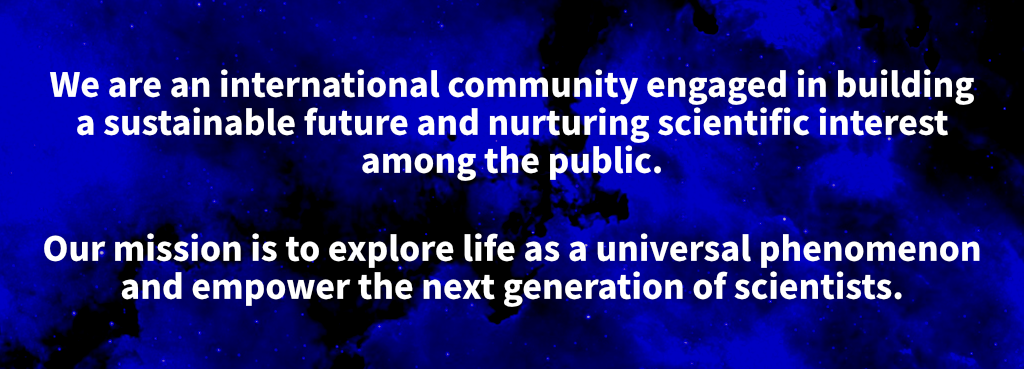Welcome to the Blue Marble Space Institute of Science (BMSIS)

Our research scientists engage in interdisciplinary research using virtual communication tools to collaborate and share ideas. We publish our research in academic journals, and we engage the public in thinking about science by sharing our research through various platforms such as SAGANet.
We pursue scientific, historical, philosophical, and transdisciplinary perspectives of questions such as:
- How did life on Earth originate, and how long will Earth remain habitable for humans?
- What environmental analogues on Earth can help us understand the environments of other planets?
- How do human civilization and the Earth system co-evolve?
- What technologies allow the human civilization to co-exist with a dynamic planet?
- What human spaceflight models will be effective in short-term transportation of humans into low-Earth orbit as well as long-term travel to the Moon, Mars, and beyond?
- Has life ever developed on another planet in the Solar System?
- How unique is Earth among other planets in the galaxy.
Our science is funded through a combination of government grants, private grants, sponsored research, and private donations.
Specific areas of research and activity among our affiliates include: planetary habitability · origins of life · astrobiology · climate change · sustainable development · human spaceflight · solar system exploration · remote space exploration · global catastrophic risk · science communication · moral philosophy · and more!
As a non-profit, any donations will support our research and public outreach, and contributions may be tax deductible. We welcome you to contact us if you have any questions or if you are interested in partnering with us!
Email*: info@bmsis.org
Web: www.bmsis.org
Twitter: @BlueMarbleSpace
Blue Marble Space Institute of Science
600 1st Avenue, 1st Floor
Seattle, Washington 98104
*Due to high volumes, we are no longer able to answer individual queries about the Young Scientist Program. Please refer to the FAQ for further information.
More About Blue Marble Space
Blue Marble Space (BMS) operates with a 15% overhead rate, which is comparably lower than other research institutes and universities. Our low overhead rate on grants received through the organization is enabled by our lean management costs, scalable cloud-based technology infrastructure, custom administrative software, and the geographic distribution of our affiliates. This low overhead rate also gives us flexibility to support the efforts of our various initiatives.
Any projects we undertake, including any grant funding, align with our organizational values and our code of ethics, which reflect our mission to promote and enable international unity through space exploration. Accordingly, all research or education grants submitted through our organization either include a robust education and public outreach (EPO) strategy or commit to creating or using tools through BMS for broader dissemination of research results and communication with the public. All of our research scientists actively engage in EPO as an integral part of their career, which reflects our institute’s commitment toward bridging the gap between scholarly and public knowledge. Our recruitment process reflects our effort to build a culture of scientists committed to EPO, enabled by the flexibility and low cost of our geographically distributed organization.
Blue Marble Space Institute of Science is an initiative of Blue Marble Space, a non-profit public charity organized under section 501(c)(3) of the U.S. Internal Revenue Code. Documents describing our organizational structure or tax exempt status are available on the Blue Marble Space website.
Blue Marble Space Institute of Science is a registered trademark of Blue Marble Space corporation. No claim is made to the exclusive right to use “space institute of science” apart from the mark as shown.
BMSIS and Community Engagement
Blue Marble Space (BMS) defines community engagement as a genuine desire to converse with audiences having little connection with sources of knowledge familiar to the communicator. An audience can be the broader scientific community outside of one’s own discipline, early-career scientists, educators, policy makers, and the interested public. The purpose of the engagement is to enable the audience and the communicator to make new authentic conclusions given new shared knowledge.
How to Join BMSIS
There are a variety of ways in which you may join our community and/or our research institution.
If you are a research scientist, an emeritus researcher, a professor looking for an affiliation outside of your home institution, a professional in science communication, or an educator, then you may wish to pursue affiliation with BMSIS. We have a Research Scientist affiliation track as well as a track in Science Communication & Education that you can explore.
If you are a graduate student or professional in research, science communication, or education and you wish to work with one of our affiliates, then you may wish to consider our Visiting Scholars Program.
If you are an undergraduate student or have finished undergrad and haven’t yet found your path toward graduate school or a professional career within science, then you might be interested in considering our Young Scientist Program.
Finally, if none of the above programs fit you, but you would like to stay in touch and hear updates about our work, be notified of new opportunities as they come up, and receive regular information about current events within astrobiology and the Earth and space sciences, then you may wish to consider signing up for our BMS Insider newsletter.

